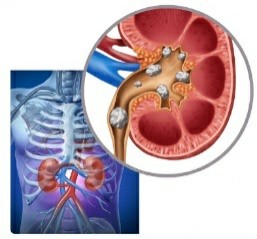As a leading research services provider specializing in rare kidney diseases, our company is committed to advancing therapeutic solutions for nephrolithiasis, commonly known as kidney stones. We focus on understanding the intricate pathophysiology of stone formation and provide comprehensive support to pharmaceutical companies and research institutions in developing novel therapeutics.
Introduction to Nephrolithiasis
Nephrolithiasis, commonly known as kidney stone disease, affects a significant portion of the global population. The prevalence of nephrolithiasis is estimated to be around 10-15% in developed countries, with recurrence rates as high as 50% within 5-10 years. Recent studies highlight the influence of genetic, dietary, and lifestyle factors in the pathogenesis of kidney stones, with metabolic disorders such as hypercalciuria and hyperoxaluria playing critical roles.
Pathogenesis of Nephrolithiasis
Nephrolithiasis entails the development of solid mineral and salt deposits within the kidneys, primarily caused by disruptions in urine composition. These disturbances often result from elevated levels of calcium, oxalate, and uric acid, which facilitate crystallization. Recent research sheds light on the intricate pathogenesis of kidney stones, emphasizing factors such as renal tubular damage, genetic predisposition, and changes in gut microbiota, providing a deeper understanding of this condition.
 Fig.1 Initiation of "chemokine to cytokine to chemokine" cascade. (Wigner, P., et al., 2021)
Fig.1 Initiation of "chemokine to cytokine to chemokine" cascade. (Wigner, P., et al., 2021)
Biomarkers in Nephrolithiasis Diagnostics
The identification of potential biomarkers is crucial for advancing kidney stone diagnostics. Inflammatory biomarkers can provide insight into the underlying mechanisms contributing to stone formation and assist in early detection and prognosis.
Table 1. Potential biomarkers in kidney stone diagnostics. (Wigner, P., et al., 2021)
| Compound (Abbreviation) |
Physiological Role |
Disfunction in the Nephrolithiasis Course |
Biological Samples |
| α-tocopherol |
A type of vitamin E that has antioxidant capacity to reduce lipid peroxidation. |
Reduced level |
Serum |
| 8-oxoG |
An oxidised derivative of deoxyguanosine and is one of the major products of DNA oxidation. |
Increased level |
Urine |
| Nitrotyrosine |
Tyrosine nitration product mediated by reactive nitrogen species, including peroxynitrite anion and nitrogen dioxide. |
Increased level |
Renal cortex and medulla imply |
| Superoxide dismutase (SOD) |
An enzyme that converts superoxide radicals into oxygen and hydrogen peroxide. |
Reduced activity |
Serum |
| Glutathione peroxidase (Gpx) |
An enzyme that safeguards against oxidative damage by converting lipid hydroperoxides to alcohols and hydrogen peroxide to water. |
Reduced activity |
Serum |
| Malonyl dialdehyde (MDA) |
A marker of lipid peroxidation of polyunsaturated fatty acids, including arachidonic acid |
Increased level |
Urine |
Disclaimer: Protheragen focuses on providing preclinical research services. This table is for information exchange purposes only. This table is not a treatment plan recommendation. For guidance on treatment options, please visit a regular hospital
Therapeutics Development for Nephrolithiasis
Cell therapy and gene therapy represent a significant shift from traditional therapy paradigms, focusing on correcting underlying genetic causes or replacing damaged cellular components, and hold the promise of transforming the management of renal ciliopathies.
Small Molecule Drug
Small molecule drug development for nephrolithiasis focuses on finding compounds that can prevent stone formation or facilitate stone dissolution. For example, research has identified certain inhibitors that target specific enzymes responsible for crystal aggregation in the kidneys, such as the recent development of Lithostat, which inhibits urease production, thereby reducing stone formation.
Therapeutic Antibody
Therapeutic antibody development aims to target specific proteins involved in kidney stone formation. A promising advancement is the creation of monoclonal antibodies that inhibit osteopontin, a protein linked to stone nucleation and growth. Such antibodies can potentially decrease stone formation rates by interrupting critical pathways in the stone-forming process.
Our Services
Our company is dedicated to providing comprehensive services that empower clients to develop innovative therapies for nephrolithiasis. Our expert team of scientists, nephrologists, and geneticists utilize cutting-edge technologies and deep expertise to accelerate your therapeutic development. We are committed to driving research and innovation to tackle the unique challenges posed by nephrolithiasis.
Types of Nephrolithiasis
With our deep expertise, we are committed to advancing the research and development of therapies for nephrolithiasis. By leveraging a profound understanding of the genetic and metabolic complexities of this condition, our team delivers tailored solutions to accelerate the discovery and implementation of effective treatments.
- Adenine-Phosphoribosyl-Transferase Deficiency
- Primary Hyperoxaluria
Our company is dedicated to offering complete, one-stop preclinical development services, covering all aspects from disease model creation to cutting-edge therapeutic research. Additionally, we provide comprehensive pharmacokinetics and drug safety evaluation services to ensure rigorous assessment and support for successful drug development.
References
- Kovacevic, L. "Diagnosis and Management of Nephrolithiasis in Children." Pediatr Clin North Am 69.6 (2022): 1149-64.
- Wigner, P., et al. "The Molecular Aspect of Nephrolithiasis Development." Cells 10.8 (2021).
All of our services and products are intended for preclinical research use
only and cannot be used to diagnose, treat or manage patients.



 Fig.1 Initiation of "chemokine to cytokine to chemokine" cascade. (Wigner, P., et al., 2021)
Fig.1 Initiation of "chemokine to cytokine to chemokine" cascade. (Wigner, P., et al., 2021)


